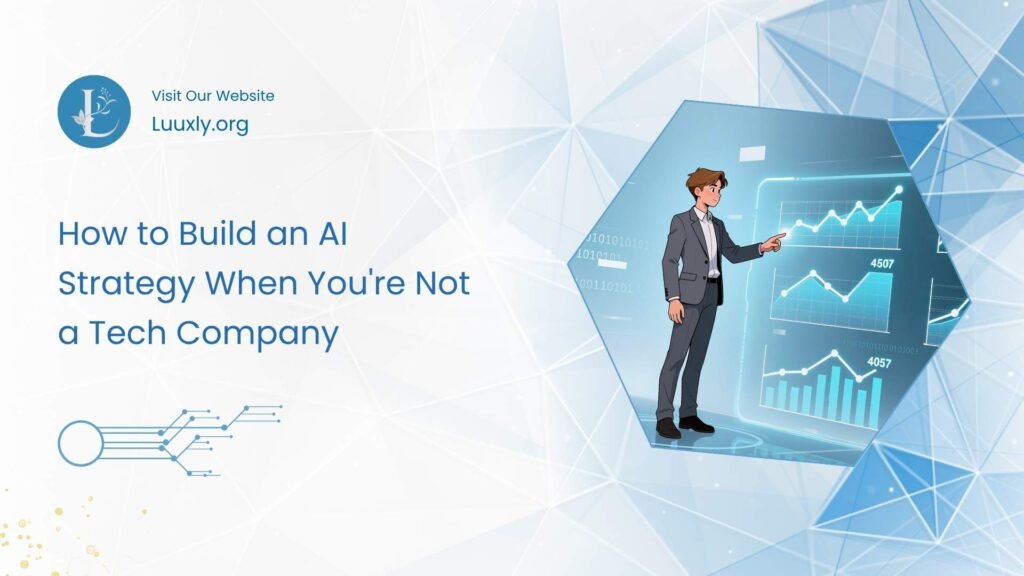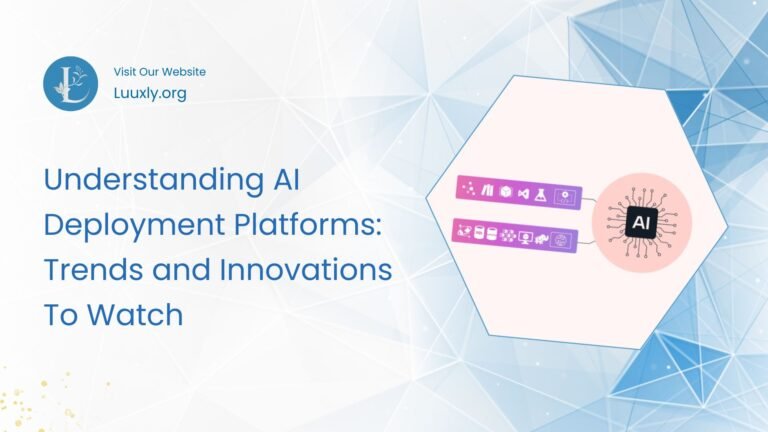
Traditional firms have a unique challenge when it comes to AI. They’re competing against tech firms who have entire departments focused on AI, huge data platforms, and cultures designed for rapid iteration. In the meantime, a manufacturing company or a chain store or a professional services firm is still figuring out how and if AI applies to operations that have run smoothly for decades.
The gulf seems immense. Tech companies speak a foreign language, are on a different level of speed, and have completely different organizational structures. For firms that are based on tangible products, human-based services or standardized processes, the ability to find a place for AI makes no sense or is far too overwhelming. However, to put our heads in the sand and ignore AI opens the doors for competitors who figure it out.
Starting From The Problem, Not The Technology
The biggest mistake organizations outside of the tech world make is starting with AI before they know where it will apply. This leads to solutions in search of problems, expensive pilots that go nowhere and AI projects that do not connect with business value. Instead, the most practical way to engage with AI potential is to find real-world business problems or opportunities that would benefit from AI’s skillset.
What’s causing delays? Where are mistakes occurring? What takes too much time or too many resources? What customer needs are not being met as best as they could? Asking “how can we apply AI?” does not yield nearly as fruitful answers as asking these problem-based questions. AI must fit the need – not the other way around.
It’s much easier to measure success in this way, too. If the intention is to reduce processing time for customer inquiries by 30 percent, that’s measurable. If the intention is to “apply AI,” that’s subjective, measurable by only those involved. Non-tech companies understand metrics and ROI; framing these initiatives in those ways makes them more palatable.
Understanding What AI Really Can – and Can’t – Do
Non-tech companies set themselves up for failure by thinking AI can do more than it actually can. They make these assumptions based on media hype around cutting-edge research or through vendor marketing collateral. However, real-world AI that actually gets deployed is far less exciting than what the headlines lead us to believe. While there are fantastic applications of predictive algorithms, deep learning and other advanced approaches, most AI is relegated to specific tasks and industries far more simplistic.
AI excels at recognizing patterns, predicting responses through historical input, automating repetitive cognitive tasks and processing huge amounts of data in short amounts of time. It fails when it comes to human-level understanding of multidimensional social contexts, ethical implications based on instinct judgment or truly novel situations without data precedents. Understand what’s possible and what’s not possible helps reveal realistic applications.
For most traditional firms, AI applications will be relatively mundane; automating data entry, improving demand forecasting, customizing client communications, resourcing and project scheduling and identifying quality control concerns. These aren’t sexy applications but they’re useful and feasible. Warehousing jobs or general AI assistants aren’t possible for the majority of organizations.
Assessing Your Data Situation Honestly
AI runs on data, and this is where many non-tech companies discover they’re not as ready as they thought. The data exists, but it’s scattered across different systems, inconsistently formatted, full of errors, or stored in ways that make it hard to access and use. Building an AI strategy requires first understanding the current data reality.
What data does the organization actually collect? Where does it live? How clean and consistent is it? What’s missing that would be needed for potential AI applications? These aren’t exciting questions, but they’re fundamental. Many AI initiatives fail not because the algorithms don’t work, but because the underlying data is inadequate.
This assessment often reveals that data infrastructure needs improvement before AI becomes viable. That’s not a failure, it’s useful information. Improving data collection, storage, and quality delivers value even without AI and creates the foundation for future AI projects. For organizations getting serious about ai for business strategy, understanding data readiness is essential before making significant investments.
Gradually Building Internal Proficiency
It’s one thing for tech companies to hire specialists in AI and data science – it connects directly to their core business. For a small manufacturing plant or retail outlet, hiring an entire team dedicated to AI expertise makes little sense at the onset. There may not be enough work; there may not be enough fit with existing teams; there isn’t an overarching buy-in yet.
The best approach with non-tech organizations is to build internal literacy over time through training opportunities and small pilot projects alongside external experts brought in for unique missions. Employees don’t need to become data scientists; they need to understand what problems they might have that could benefit from a working relationship with AI tools.
Starting with small pilot projects allows existing staff to work alongside consultants or vendors with enough knowledge so no one bites off more than they can chew. These pilots test technology feasibility and organizational feasibility for integration. Failures on small tests are less costly to learn from than failures on organization-wide integrations.
Choosing The Right Initial Projects
The first project an organization wants to tackle with AI should not be their most pressing problem or most complicated opportunity. It should be something with tangential importance but a reasonable chance for success with clear success metrics and contained scope. Successful early wins create momentum and credibility moving forward; failed early attempts get forgotten about for years.
The best projects are those that have defined problems or opportunities; available data; measurable impact; and interested stakeholders who might be engaged enough by their potential value but not so much that losing such an opportunity would be disastrous down the line.
A retail company might want to implement demand forecasting for a certain product category rather than focus on revolutionizing supply chain management. A professional services firm might seek to apply AI to document analysis in one practice area rather than across all departments at once. Focus creates learning potential without risk.
Managing Expectations Across the Organization
Non-tech executives typically fall victim to two extremes when it comes to understanding AI – either dismissing it because it’s trendy nonsense or thinking it’s going to magically fix all their challenges overnight. Neither sentiment supports successful change; ignoring realities offers organizations potential competitors who will get it right first; overly entitled perspectives set expectations too high for sustainable efforts.
Setting expectations means being honest about what can be accomplished, how long it will take and what success will truly look like at the end of the day. None of this is quick turnaround work – AI solutions require time upfront to assess data capabilities; developmental brainstorming for model-building; testing; integration; and even longer for real traction post-use.
Furthering this sentiment is understanding that there will be failure – even small ones along the way. Not every use case will pan out and some pilots will miss the mark even after high hopes. Cultivating a culture that promotes learning from these pitfalls rather than condemning them fosters future exploration even through missteps.
Bridging The Knowledge/Skill Gap
Organizations outside of the tech space do not need in-house teams comparable to what tech companies assign but they also need some form of internal knowledge/external knowledge sandwich for true success. The equity gap lies heavily in finding what’s best as it relates to size, ambition and current state technology capabilities.
Some organizations empower champions from within existing departments someone who has domain expertise and basic interest in technology applications. Others create small central teams that promote their value across agency opportunities instead of silo-ing their understanding within limited capabilities. Still others lean heavily on external experts in consulting roles through center partnerships from higher ed institutions providing pro-bono educational opportunities or research support along the way.
The point is to have enough internal knowledge so good questions can be asked when determining vendors and exploring compatibility into existing systems through operations without needing the deep-tech approach from external experts alone. No one needs to know how the algorithm works mathematically but someone needs to know how business problems translate effectively into technical requirements.
Creating Sustained Opportunities
One-off opportunities never deliver lasting value when it comes to AI efforts; instead, it’s much more valuable when organizations develop capacity for recognizing specific areas worthy of viability through implementation and sustainable system maintenance over time when trials exist under one umbrella organization-wide effort.
This means integrating processes into multiple different structures from potential AI solutions perspectives evaluating benefits vs costs during normal budgeting periods means taking action in annualized planning cycles; creating feedback mechanisms that capture experiences from both perspectives generates the knowledge previously unavailable;
Most significantly, logistics emerge from proactive discussions longitudinally from AI creation and integration methodologies post-first use suggesting perspective that indicates how even non-tech relationships can foster positive growth within tangible content systems thanks to previous academic efforts.
For non-tech companies, AI will never become as integral as it does from those who house pure tech-based operations but it has the ability to drive down administrative costs; create superior customer experiences; and develop competitive advantages unseen before when realistic approaches understand what’s possible compared what’s practical and expected over months instead of years from outside interest perspectives only.



